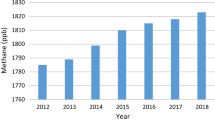Abstract
In this study, we determine the global emission concentration of methane using the scanning imaging absorption spectrometer for atmospheric chartography data. We analyzed land and sea area to investigate the 9-year changes in methane concentrations from 2003 to 2011. Moreover, by subtracting the concentration of methane from land and sea, we can found the methane emission concentration of land. As a result, it is cleared that a big amount of CH4 emission concentration was found not only in the northern Hemisphere paddy fields but also in the southern Hemisphere broadleaf evergreen areas (central Africa and south America). We also found that the global land CH4 growth rate is 3–5 ppb/year during 9 years.







Similar content being viewed by others
Explore related subjects
Discover the latest articles, news and stories from top researchers in related subjects.References
Braga do Carmo J, Keller M, Dias JD, de Camargo PB, Crill P (2006) A source of methane from upland forests in the Brazilian Amazon. Geophys Res Lett 33:L04809. doi:10.1029/2005GL025436
Conway TJ (1994) Evidence for interannual variability of the carbon cycle from the NOAA/CMDL sampling network. J Geophys Res 99(D11):22831–22855
De Dils BM, Mazière JF, Müller T, Blumenstock M, Buchwitz R et al (2006) Comparisons between SCIAMACHY and ground-based FTIR data for total columns of CO, CH4, CO2 and N2O Atmos. Chem Phys 6:1953–1976
Frankenberg C, Meirink JF, van Weele M, Platt U, Wagner T (2005) Assessing methane emissions from global space-borne observations. Science 308:1010–1014
Frankenberg C, Bergamaschi P, Butz A, Houweling S, Meirink JF et al (2008) Tropical methane emissions: a revised view from SCIAMACHY onboard ENVISAT. Geo Res Lett 35(15)
IPCC (2001) Contribution of working group I to the third assessment report of the intergovernmental panel on climate change. In: Houghton JT, Ding Y, Griggs DJ, Noguer M, van der Linden PJ, Dai X, Maskell K, Johnson CA (eds) Climate change 2001: the scientific basis. Cambridge University Press, Cambridge. http://www.grida.no/publications/other/ipcc_tar/
IPCC (2007) Contribution of working group I to the fourth assessment report of the intergovernmental panel on climate change. In: Solomon S, Qin D, Manning M, Chen Z, Marquis M, Averyt KB, Tignor M, Miller HL (eds) Climate change 2007: the physical science basis. Cambridge University Press, Cambridge. http://www.ipcc.ch/publications_and_data/ar4/wg1/en/contents.html
Keeling CD, Whorf TP, Wahlen M, van der Plicht J (1995) Interannual extremes in the rate of rise of atmospheric carbon dioxide since 1980. Nature 375:666–670
Keeling RF, Piper SC, Heimann M (1996) Global and hemispheric CO2 sinks deduced from changes in atmospheric O2 concentration. Nature 381:218–221
Keppler F, Hamilton JTG, Brass M, Rockmann T (2006) Methane emissions from terrestrial plants under aerobic conditions. Nature 439:187–191
Keppler F, Hamilton JTG, McRoberts WC, Vigano I, Brass M, Röckmann T (2008) Methoxyl groups of plant pectin as a precursor of atmospheric methane: evidence from deuterium labelling studies. New Phytol 178:808–814
Langenfelds RL et al (2002) Interannual growth rate variations of atmospheric CO2 and its delta C-13, H-2, CH4, and CO between 1992 and 1999 linked to biomass burning. Global Biogeochem Cycles 16(3):1048. doi:10.1029/2001GB001466
Lelieveld J (2006) Climate change: a nasty surprise from the greenhouse. Nature 443:405–406
Lelieveld J, Butler TM, Crowley JN, Dillon TJ, Fischer H, Ganzeveld L, Harder H, Lawrence MG, Martinez M, Taraborrelli D, Williams J (2008) Atmospheric oxidation capacity sustained by a tropical forest. Nature 452:737–740
Marland G, Boden TA, Andres RJ (2006) Global, regional, and national CO2 emissions. In: Trends: a compendium of data on global change. Carbon Dioxide Information Analysis Center, Oak Ridge National Laboratory, US Department of Energy, Oak Ridge, TN, http://cdiac.esd.ornl.gov/trends/emis/tre_glob.htm
Miller JB, Gatti LV, d’Amelio MTS, Crotwell AM, Dlugokencky EJ, Bakwin P, Artaxo P, Tans PP (2007) Airborne measurements indicate large methane emissions from the eastern amazon basin. Geophysiol Res Lett 34:L10809. doi:10.1029/2006GL029213
Nakazawa T, Moromoto S, Aoki S, Tanaka M (1997) Temporal and spatial variations of the carbon isotopic ratio of atmospheric carbon dioxide in the Western Pacific region.J. Geophys Res 102:1271–1285
Nisbet R, Fisher R, Nimmo R, Bendall D, C PM, Gallego-Sala A, Hornibrook E, L′opez-Juez E, Lowry D, Nisbet P, Shuckburgh E, Sriskantharajah S, Howe CJ, Nisbet EG (2009) Emission of methane from plants. Proc R Soc 276:1347–1354. doi:10.1098/rspb 2008.1731
Prentice IC et al (2001) The carbon cycle and atmospheric carbon dioxide. In: Houghton JT et al (eds) Climate change 2001: the scientific basis. Contribution of working group I to the third assessment report of the intergovernmental panel on climate change. Cambridge University Press, Cambridge, New York, pp 184–238
Warwick NJ, Bekki S, Law KS, Nisbet EG, Pyle JA (2002) The impact of meteorology on the interannual growth rate of atmospheric methane. Geophys Res Lett 29:1947. doi:10.1029/2002GLO15282
Zhi-pingwang Xing-guohan, Geoffwang G, Yangsong, Jaygulledge (2008) Aerobic methane emission from plants in the inner mongolia steppe. Environ Sci Technol 42:62–68
Acknowledgments
This research was supported by JSPS KAKENHI Grant-in-Aid for Scientific Research (C) and the Research project of Tokyo University of Information Sciences for the sustainable development of economic and social structure dependent on the environment in eastern Asia.
Author information
Authors and Affiliations
Corresponding author
About this article
Cite this article
Park, J., Park, S., Kwak, Y. et al. Analysis of seasonal variability of methane over global land area. Artif Life Robotics 19, 40–46 (2014). https://doi.org/10.1007/s10015-013-0128-7
Received:
Accepted:
Published:
Issue Date:
DOI: https://doi.org/10.1007/s10015-013-0128-7




